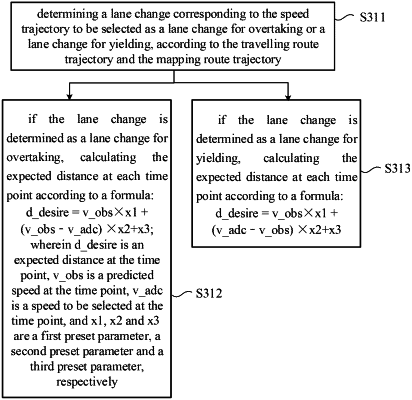| CPC B60W 60/0011 (2020.02) [B60W 30/18163 (2013.01); G01C 21/3453 (2013.01); G05D 1/0223 (2013.01); G05D 1/0238 (2013.01); G06V 20/58 (2022.01); B60W 2554/4041 (2020.02); B60W 2754/10 (2020.02)] | 14 Claims |

|
1. A method for planning a speed of an autonomous vehicle, comprising:
generating a plurality of speed trajectories to be selected for the autonomous vehicle before the autonomous vehicle changes a lane, wherein each speed trajectory of the plurality speed trajectories to be selected comprises the speeds to be selected at a plurality of time points within a preset time range;
obtaining predicted speeds and predicted positions of an obstacle at the plurality of time points;
calculating a cost function value of each speed trajectory of the plurality of speed trajectories to be selected of the autonomous vehicle, according to the plurality of speed trajectories to be selected of the autonomous vehicle, and the predicted speeds and the predicted positions of the obstacle at the plurality of time points, comprising:
setting, according to the speed to be selected of the autonomous vehicle at each time point, the predicted speed of the obstacle at each time point, a result of determining whether a lane change corresponding to the speed trajectory to be selected is a lane change for overtaking or a lane change for yielding, and a preset parameter, an expected distance at each time point, wherein the expected distance is a safe distance from the autonomous vehicle to the obstacle set to avoid a collision between the autonomous vehicle and the obstacle,
for each speed trajectory to be selected, calculating the cost function value of the speed trajectory to be selected at each time point according to the expected distance and a distance to be selected at each time point, wherein the distance to be selected is a distance from the autonomous vehicle to the obstacle on the speed trajectory to be selected, and
obtaining the cost function value of the speed trajectory to be selected within the preset time range according to the cost function value of the speed trajectory to be selected at each time point; and
selecting a speed trajectory to be selected with a minimum cost function value, as a planning speed trajectory of the autonomous vehicle;
wherein the setting, according to the speed to be selected of the autonomous vehicle at each time point, the predicted speed of the obstacle at each time point, a result of determining whether a lane change corresponding to the speed trajectory to be selected is a lane change for overtaking or a lane change for yielding, and a preset parameter, comprises:
generating a travelling route trajectory in a route-time coordinate system according to the speed trajectory to be selected, wherein a horizontal axis and a longitudinal axis of the route-time coordinate system denote a time and a position respectively;
mapping a plurality of predicted positions of the obstacle into the route-time coordinate system to obtain a mapping route trajectory of the obstacle, according to a correspondence relation to the time points;
determining, according to the travelling route trajectory and the mapping route trajectory, the lane change corresponding to the speed trajectory to be selected as a lane change for overtaking or a lane change for yielding; and
calculating the expected distance at each time point using a first calculating method in response to the lane change being determined as a lane change for overtaking, and calculating the expected distance at each time point using a second calculating method in response to the lane change being determined as a lane change for yielding.
|